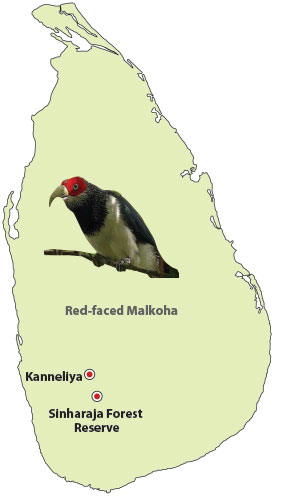Have you ever heard of a bird with a bright red skin around its eyes, a long tail, and a secretive nature? Say hello to the Red-Faced Malkoha—one of the most special birds living right here in Sri Lanka.
The Red-Faced Malkoha (scientific name: Phaenicophaeus pyrrhocephalus) is found only in Sri Lanka, which makes it an endemic species. That means you won’t find this bird flying around in places like India, Africa, or anywhere else—just right here in our beautiful island home.
Where does it live?
This shy bird loves to live in rainforests, especially in the Wet Zone of Sri Lanka—places like Sinharaja Forest Reserve and Kanneliya. These forests are full of tall trees, thick vines, and lots of other animals.
The Malkoha likes to hide among the leaves, —they are very shy. They usually stay high up in the trees and rarely come down to the lower branches, so you’ll need sharp eyes and quiet footsteps to spot one.
What does it look like?
The Red-Faced Malkoha is quite the beauty and rather big—around 46 cm long. You can recognise them by its, greenish-black body with a shiny, silky look, and a long tail that helps it balance while hopping on branches
Most famously, it has bright red bare skin around its eyes—like it’s wearing red glasses, a bright red face, a white underbelly and a long black tail with a white tip.
Boys and girls look a bit different too:
*Females are bigger and have white eyes
*Males are smaller and have brown eyes
Even though it’s part of the cuckoo family, it doesn’t lay eggs in other birds’ nests like some cuckoos do.
Are they loud?
Nope. These birds are not noisy at all. If you’re lucky, you might hear a soft “krrrr” sound, or some clicks from their beaks and hisses if they get excited—but that’s very rare.
How do they raise chicks?
These birds build small, shallow nests in the forks of tree branches using twigs, roots, leaves, and grass. Not many people have seen their nests, so we still have a lot to learn about them.
They usually lay two or three white eggs around May, and the eggs are a little larger than marbles.
What does it eat?
The Red-Faced Malkoha is always on the move, looking for tasty treats. It eats:
*Insects like caterpillars, grasshoppers, and beetles
*Small reptiles
*Sometimes even fruits and berries
It uses its curved beak to poke around in tree barks and leaves to search for snacks.
Is the Malkoha in danger?
Sadly, yes. The Red-Faced Malkoha is listed as “Near Threatened” because:
*Many of its rainforest homes are being cut down
*It needs a quiet, safe place to live, and forests are getting smaller
When we destroy forests, we make life harder for the Malkoha and many other animals who call the jungle their home.
How can we help?
Even children can help protect this beautiful bird. Here’s how:
*Learn more about Sri Lanka’s amazing wildlife
*Talk to friends and family about saving forests
*Join nature clubs or tree-planting events
*Never throw trash in forests or near animal homes
The more we care, the more others will too.
Why it matters?
The Red-Faced Malkoha is more than just a pretty bird. It’s a symbol of Sri Lanka’s rich biodiversity. Protecting it means protecting our forests, our future, and the balance of nature.
So next time you visit a rainforest or read about birds, remember this shy red-faced beauty swinging through the trees. And remember—you’re part of its story too.
Let’s be little guardians of the forest and help the Red-Faced Malkoha keep singing for years to come.









